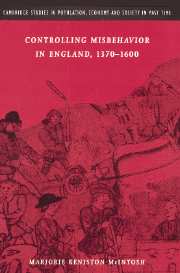Book contents
- Frontmatter
- Contents
- 1 List of illustrations
- 2 List of tables and lists
- Acknowledgements
- List of abbreviations
- Introduction
- Part I The history of social regulation
- 1 The forms of control
- 2 Methodological underpinnings
- 3 Social regulation in England's smaller communities
- 4 Social concern in other contexts
- Part II Factors that influenced social regulation
- Conclusion: social regulation and the transition from medieval to early modern England
- Appendices
- Bibliography
- Index
- Cambridge Studies in Population, Economy and Society in Past Time
2 - Methodological underpinnings
Published online by Cambridge University Press: 23 November 2009
- Frontmatter
- Contents
- 1 List of illustrations
- 2 List of tables and lists
- Acknowledgements
- List of abbreviations
- Introduction
- Part I The history of social regulation
- 1 The forms of control
- 2 Methodological underpinnings
- 3 Social regulation in England's smaller communities
- 4 Social concern in other contexts
- Part II Factors that influenced social regulation
- Conclusion: social regulation and the transition from medieval to early modern England
- Appendices
- Bibliography
- Index
- Cambridge Studies in Population, Economy and Society in Past Time
Summary
The information to be presented in Chapters 3, 6, and 7 about social regulation in 255 smaller communities derives from an unfamiliar method of working with local court records. Since that technique has implications for the patterns observed, it needs to be described in some detail. As long as the methodological constraints of the approach are kept firmly in mind, it offers some significant benefits, enabling us to utilize a large mass of records previously employed only for local research to trace responses to misbehavior in all parts of the country over more than two centuries, including the especially obscure fifteenth century.
It was necessary first to establish criteria for the types of communities and courts to include. My decision to focus upon courts held in villages and market centers with fewer than about 3,000 inhabitants, excluding England's urban communities, stemmed from both intellectual and practical factors. The great majority of the population lived in the smaller places, so their experience was characteristic, yet we know very little about them as compared to the better studied urban areas. Moreover, voluminous masses of records survive for some of the bigger places, more than I could reasonably tackle. Because my approach required that I be certain that each court included did indeed exercise public jurisdiction and thus had the potential authority to handle social misconduct, I eliminated all courts with only baronial status. The type of court as indicated on its own rolls was not in itself a reliable guide to whether it could deal with public matters, especially in the northern part of the country, for there was considerable variation in how even a given court titled itself over time.
- Type
- Chapter
- Information
- Controlling Misbehavior in England, 1370–1600 , pp. 46 - 53Publisher: Cambridge University PressPrint publication year: 1998



